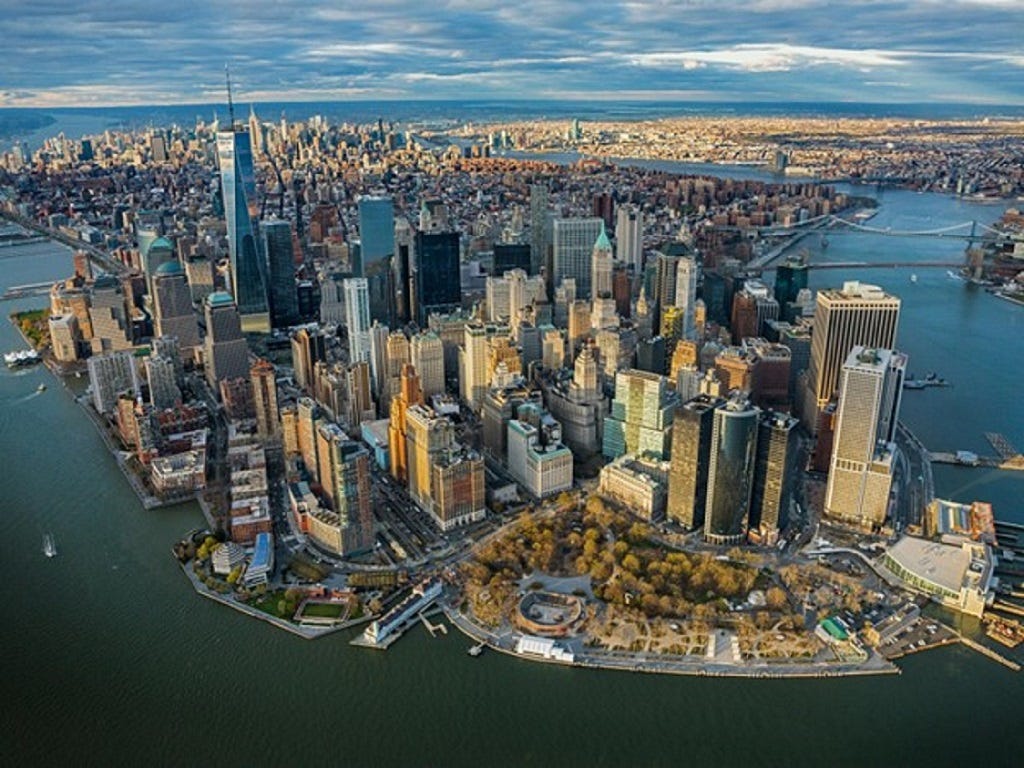Democracy done right in NYC mayor’s race using RCV
Ranked Choice Voting freed up New Yorkers to pick the candidates they really like. An exit poll shows all demographics liked and understood RCV
[Dear readers: DemocracySOS would like to welcome guest author Nathan Lockwood. Nathan is co-founder and past-Executive Director of Rank The Vote, now its Director of Strategy & Advancement. Rank The Vote is one of the premier RCV advocacy groups in the US, working with groups in more than half the states to build a nationwide movement to change our elections]
In an exciting race in which Ranked Choice Voting really showed its worth, Zohran Mamdani soundly defeated former Governor Andrew Cuomo in the Democratic primary for mayor on June 24. In the nation’s largest city, Mamdani held a decisive lead in first rankings, 43.5 percent to Cuomo’s 36.4 percent, and once the RCV tabulation was applied on July 1, Mamdani widened his primary night lead, picking up another 12.5 points to Cuomo’s 7.5 points from voters’ second through fifth rankings.
The news media all said Cuomo was “unstoppable,” aided by at least one $25 million PAC war chest, stuffed full by billionaire backers and corporations on top of his standard campaign haul. As far as the celebrity-focused reporting was concerned, the narrative was the famous, albeit disgraced, former governor versus a bunch of random progressives and assorted wanna-be’s. But then something amazing started to happen -- a combination of dedicated, inspired campaigning by certain candidates, listening and connecting with everyday people — within the space and possibility opened up by RCV. Voter turnout was the highest for a mayoral race since 1989, with over a million voters ranking their ballots.
As Mamdani’s campaign started catching fire, many of those seeking a Cuomo coronation started to get nervous and complain about the voter-empowering RCV system that might stand in the way of their steamroller. Why? Because in NYC's old-style elections, the powerful can rely on big fields of similar candidates to argue with each other, split the vote and rain on the parade of upstarts. But Ranked Choice Voting flipped the script.
Tag-teaming and coalition-building
The field of “nobodies” – that actually garnered almost two-thirds of first round support of the primary electorate – did not tear each other apart. In fact, many of these candidates started to cross-endorse each other, highlighting their shared purpose and values, without sacrificing their unique claims to be the best choice.
The influential Working Families Party endorsed a set of four candidates to rank, rather than just one. Along with this shared slate, the anti-Cuomo faction united around slogans like ABC (Anybody But Cuomo) and DREAM (Don’t Rank Evil Andrew for Mayor), showing that while RCV created civility amongst the like-minded, the sharp elbows of intense competition would be used as needed. And then, when the two strongest progressives in the race, Mamdani and City Comptroller Brad Lander, formed a tight and compelling bond, it really got real.
Mamdani was seen by many as an inspiring, charismatic, and aspirational (or delusional, depending on who you are talking to) young politician whose fingers were glued to the pulse of so many in the city; and Lander was viewed as the experienced, trusted (or for some boring), former comptroller. Two progressives, youth and experience, a Muslim and a Jew – in a traditionally fractured field, each compelling as candidates but alone vulnerable – not least to the barbs they could have unleashed on each other. But under Ranked Choice Voting, they bonded into a fantastic pair to make a strong appeal together, each having the other’s back. And it could be the beginning of a new partnership, with speculation that Lander might serve as a deputy in any Mamdani administration.
The rest is now a new and exciting part of New York’s electoral history. You don’t have to be a Zohran Mamdani fan or agree with his politics to appreciate this. If you believe in democracy, government of, by, and for the people, then the ability for the voice of the many voters to be heard over the powerful few matters. Zohran Mamdani began the contest polling under 1% before engineering a brisk and steady ascent. He spoke to the cost of living from the left and it resonated, similar to the way current Mayor Eric Adams spoke to crime from the right when he ran in 2021.
In this primary election at least, David beat Goliath, and Ranked Choice Voting was the slingshot that enabled it to happen. There’s reason to believe it can keep happening – Ranked Choice Voting along with term limits and public financing of campaigns have been doing wonders for getting responsive, new blood on the NY city council. In fact, it has not been widely reported that, since RCV was first used in the 2021 elections, the number of women-of-color elected to the New York city council has increased from only a handful to 26 out of 51 seats. Yes, New York has a majority women-of-color council! And the number of women overall has reached 31 out of 51 (61%). Yes, the city council for America’s largest and most dynamic city is one of the most racial and gender diverse in the country.
Exit poll revelations
How did voters fare in this RCV election? Did they like it, hate it, find it boring? We actually have good answers from a new exit poll from SurveyUSA that was just released. The findings are extremely encouraging. New York City voters say ranked choice voting is simple, they like it, and understand it. Key findings of the poll include:
96% of NYC voters say their ballot was simple to complete, including at least 94% of each racial group surveyed.
76% say they want to keep or expand RCV to other elections, with 42% wanting to expand it to general elections and 34% wanting to keep it for primaries. Only 17% say RCV should not be used for municipal elections.
81% say they understand RCV extremely or very well, with another 16% saying they understand it somewhat well. Only 3% saying they do not understand it well.
82% say they ranked two or more candidates for mayor, with 45% reporting that they used all five of their allowable rankings.
Among voters who ranked 2 or more candidates, 58% say “ranking allowed me to vote for candidates who aligned with my values.” Among the 18% of voters who ranked only one, 87% say “that was the only candidate I liked.”
New Yorkers across ethnic groups found their ballots simple to complete:
95% of Black voters found their ballot simple to complete.
97% of Hispanic voters found their ballot simple to complete.
94% of Asian voters found their ballot simple to complete.
97% of white voters found their ballot simple to complete.
This new data confirms that voters of all demographics took advantage of RCV. And it is consistent with exit polling from New York City’s first RCV elections in 2021, which showed voters overwhelmingly understood RCV, liked it, and ranked their ballots. Exit surveys from other RCV elections in a range of cities have repeatedly found that voters like and understand RCV. No wonder Ranked Choice Voting is now used in over 50 cities, counties, and states, which are home to 17 million people.
So everything’s perfect now?
Does that mean everything is perfect now in New York City elections? Heck no. Where do we start?
The general election in November still uses traditional, broken, “pick-one candidate” plurality voting. And that could backfire in the upcoming November general election to decide the mayor’s race. With multiple candidates running, the winner could win with less than 30% of the votes because -- the general election will not use Ranked Choice Voting, which guarantees a majority winner!
In addition to Mamdani, former Democrat and incumbent mayor Eric Adams is running as an independent. And the June loser Andrew Cuomo may abuse fusion voting to run on another party’s ballot line. There will be at least two other candidates, Republican Curtis Sliwa and Independent Jim Walden, a corporate defense attorney. More choice for the larger number of general election voters should be a good thing. But with old fashioned pick-one plurality voting and no majority requirement, it’s a voter coordination problem on steroids. Many voters’ hands will be tied, as they may split their votes among so many candidates. Voters afraid of Sliwa or Adams or Cuomo or Mamdani may feel pressure to vote, not for their favorite, but for who they feel has the best chance to beat their most feared candidate. The lesser of two or three evils. With so many different voter perspectives, this amounts to a coordination problem that pick-one plurality voting simply cannot solve. The winner may well end up with less than majority support.
New York City really should be using Ranked Choice Voting in the general election, so that voters don’t split their votes and new candidates and parties can compete and grow alongside the existing major parties. Multiple, strong parties with several orientations would be invaluable for exploring, crystalizing, and amplifying the most important wishes of the diverse constituencies of NYC, and identifying, developing, and resourcing highly capable, qualified, appealing candidates to champion these perspectives. Whatever else, there needs to be Ranked Choice Voting in the November election so that new parties can compete and grow alongside the existing major parties.
Another problem: many voters were not heard from
In the just-completed primary elections that determined which candidates will go to the November general election, many New Yorkers who chose not to register with a specific political party were not allowed to participate and were therefore locked out of nominating the candidates that will appear on the November ballot. How many voters? About 22% could not vote in partisan primaries because they were independent voters; New York has closed primaries that don’t allow independent voters to participate. Turnout was low for the Democratic primary – under 20% of the total registered voters. Solutions to this might include Mobile Voting (see for example, Bradley Tusk’s blog), Universal Voting, or perhaps Open Primaries.
Whether you have been swept up in the “Mamdani Magic” or would have preferred someone else, feel good about this – New York City’s 2025 primary has shown with Ranked Choice Voting we can:
Get past cynicism and apathy by electing candidates that speak to huge swaths of voters who feel unheard
Break the power of billionaire dollars to ram candidates down the throat of the electorate
Continue improving elections with positive changes, so we get stronger parties and candidates, and people are central to the process.
Stronger elections with reforms like Ranked Choice Voting are the great hope and the great opportunity for us today. So let’s raise a glass to RCV in NYC, for letting the beacon shine in messy, real world elections that matter.
Nathan Lockwood @njlockwood






Great article. Could you clarify this data point: "76% say they want to keep or expand RCV to other elections, with 42% wanting to expand it to general elections and 34% wanting to keep it for primaries. Only 17% say RCV should not be used for municipal elections." It looks like the 76% is the combination of the 42% and 34%-- but do only 34% of voters think that NY should keep RCV for primaries? That seems low. Thanks!
It is good to see growing use of ranked choice voting in the US - writing from a country where it has been standard since the 1920s.
The idea that it is difficult is one to squash.